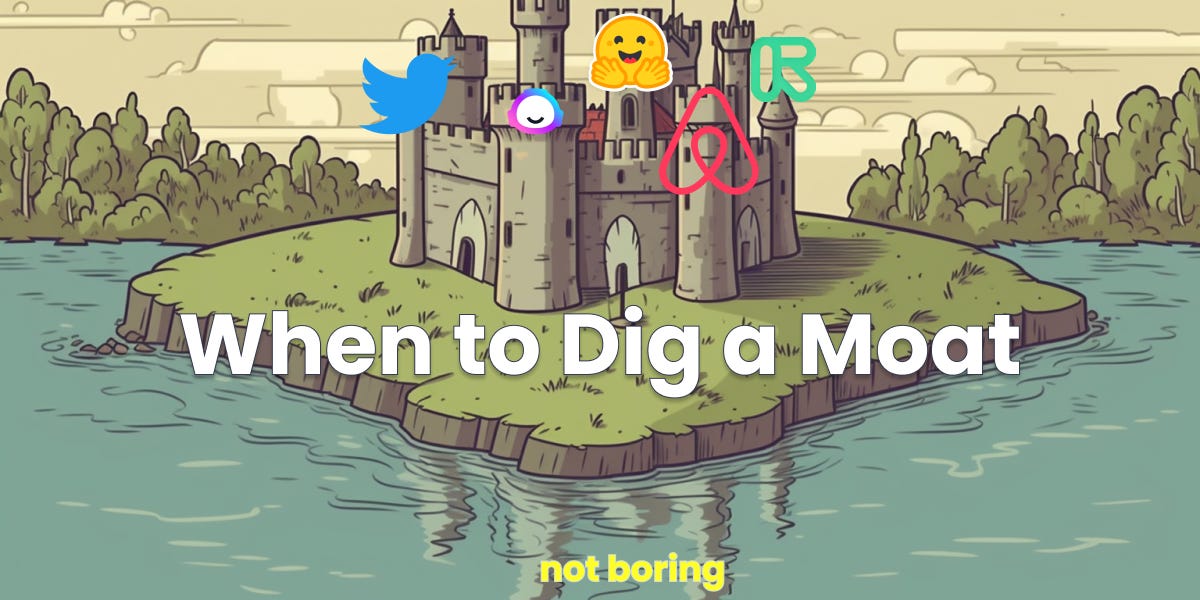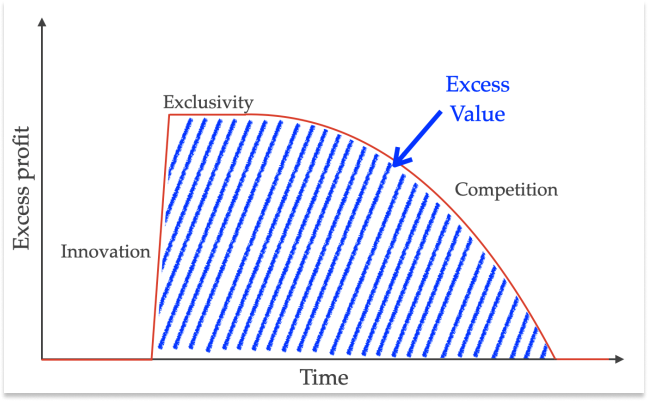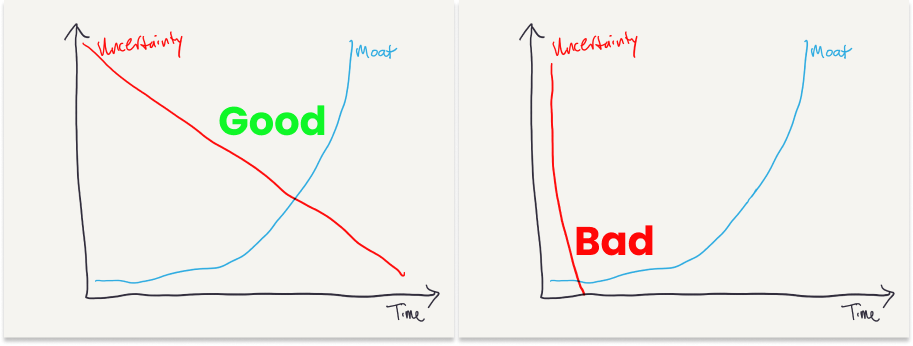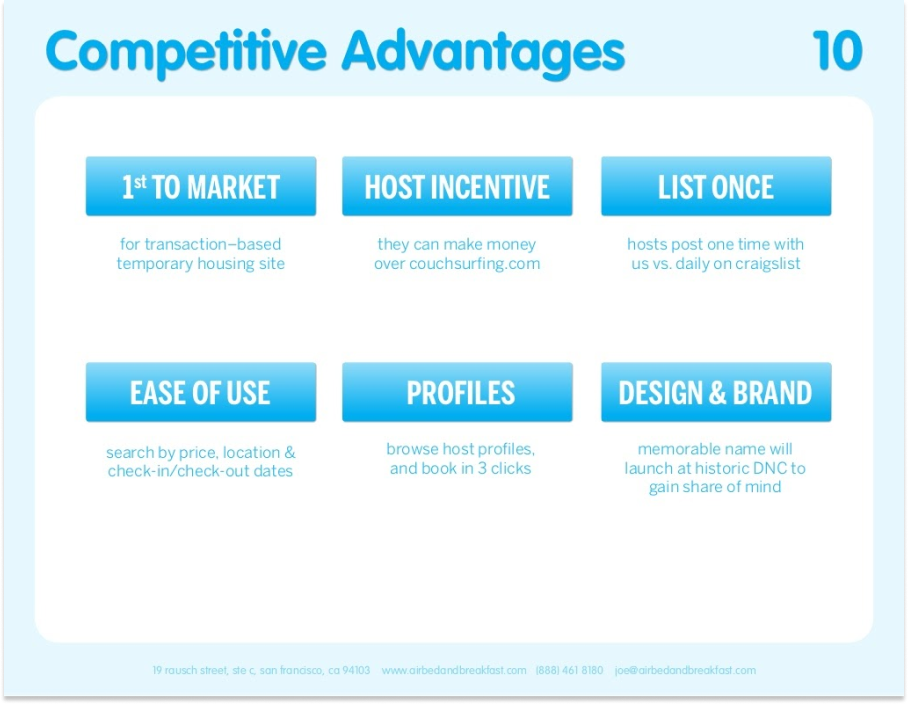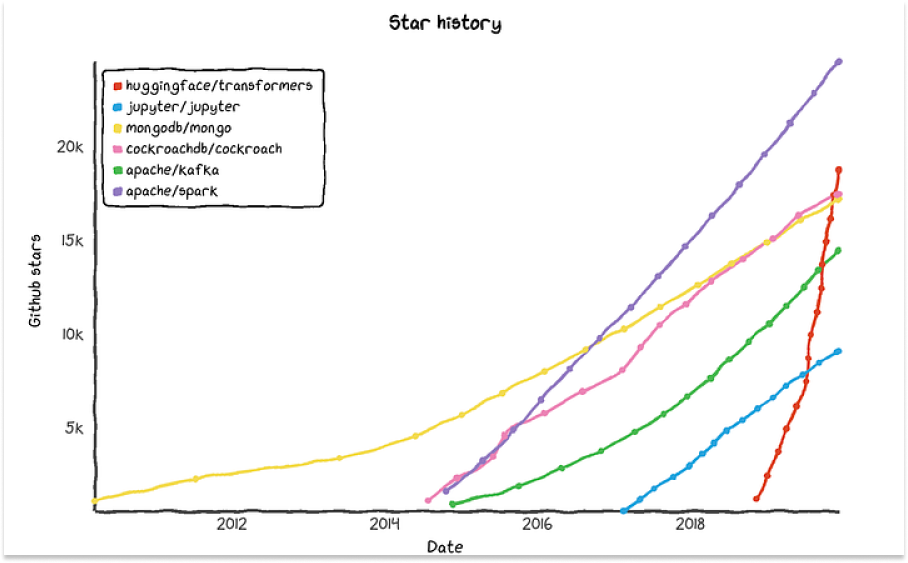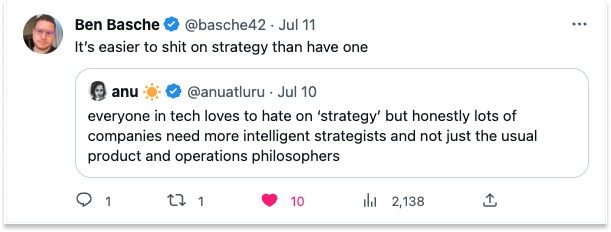Not Boring by Packy McCormick - When to Dig a Moat
Welcome to the 443 newly Not Boring people who have joined us since last Tuesday! If you haven’t subscribed, join 207,918 smart, curious folks by subscribing here: Today’s Not Boring is brought to you by… Slack I’m a long time Slack fan. This piece on Slack in 2020 was one of my first viral essays ever. Three years and tens of thousands of Slack messages later, and I’m more bullish on Slack than ever. And I’m not alone. Slack is where millions of companies – of varying sizes – get work done. We all know that everyday tasks can slow you and your team down Back-and-forth emails. Meetings on top of meetings. A never-ending to-do list. But Slack is the single space to connect with everything, share and search for information, and help your teams do more with less. And with Slack Pro, you can: Keep conversations in one place At Not Boring, all internal-team collaboration happens within Slack, but we also collaborate with portfolio companies, advertising partners, and other communities all within our main Slack workspace. Find what you need, share what you know From files to photos to conversations, everyone can access any message that’s ever been shared, so they have all the information they need to make decisions and move work forward. Crtl+f makes the world go round. Connect instantly with huddles Fun fact, Dan and I have never scheduled a video meeting. But we huddle all the time. With huddles you can talk, video chat, or share your screen instantly with anyone in your Slack. Right now, you can save 50% off your first 3 months of Slack Pro. Hi friends 👋 , Happy Tuesday! There’s been a lot of debate about the importance of moats recently. Do startups have them, or not? Do startups need them, or not? In my opinion, the conversation has lacked some depth and dimensionality, which has rendered it relatively useless for entrepreneurs and investors alike. I want to take a shot at clearing it up today. Let’s get to it. When to Dig a MoatThere’s a belief in tech that if you have the most talented team, the best product, and the fastest growth – that if you just Make Something People Want – you don’t need to worry about moats. That’s precisely wrong. Companies that have the best products, most talented people, and fastest growth are precisely the ones for which moats are most important. They’re the ones who might get lucky enough to have something to lose. They’re the ones that bigger, better-resourced or smaller, faster companies will one day compete with. And the faster they become successful, the faster they’ll face meaningful competition. Success accelerates the need for moats. As soon as success seems obvious, startups lose their training wheels moat – uncertainty – and should have at least the foundations of more permanent moats in place. There’s simply less time to fuck around now, as many companies will soon find out. To set the foundation here, what are moats? In 7 Powers, Hamilton Helmer defines them as “those barriers that protect your business’ margins from the erosive forces of competition.” He lists seven types: Economies of Scale, Network Effects, Counter-Positioning, Switching Costs, Brand, Cornered Resource, Process Power. For definitions and examples of each, check out Flo Crivello’s Mind the Moat. Moats won’t get you Product-Market Fit (PMF). You need that first before worrying about anything else, as USV’s Fred Wilson wrote in a 2013 blog post Product > Strategy > Business Model. But by the time you have PMF, by the time it’s obvious that what you’re doing could work, you should be able to protect it from the erosive forces of competition. The ultimate goal of a venture-backed startup is to go public or get acquired for roughly $1 billion or more, not to get marked up by other VCs. That can take a long time, typically seven to ten years. Even if the startup lights a fire before competitors realize what it’s doing, it needs to protect and fan that fire for many years before a successful exit. For companies at which everything is going right, moats can be the difference between IPO and cautionary tale. Puja and I were watching Tour de France: Unchained on Netflix this weekend, and I think Steve Chainel’s line on the cobblestone stage sums it up nicely: “You can’t win the Tour de France on the cobblestones… but you can lose it.” This question about moats has come up a bunch recently in the context of generative AI startups built on top of OpenAI’s APIs, ungenerously referred to as “GPT Wrappers.” On the one side are the VCs and armchair analysts who believe that GPT Wrappers have no moats. On the other are the builders who say that building great products and growing quickly is what matters most, and that moats will come later. On Friday, The Information reported that two generative AI companies, Jasper and Mutiny AI, were laying off employees. Jasper in particular had been growing very quickly. Founded in 2021, before the AI Hype Cycle, it was on track to reach $75 million in revenue this year. Last October, it rode that growth to a $1.5 billion valuation. Nine months later, it’s doing layoffs in the face of increased competition. It would seem that the company has not yet built deep enough moats to protect its fast-growing prize. It’s only been alive two years. It’s hard to blame it. What happened? Jasper simply ran out of uncertainty cover before it could build real moats. Let me explain. In Productive Uncertainty, Jerry Neumann wrote that “the only moat that can create excess value for a new startup is uncertainty” because “uncertainty keeps competition at bay long enough for a moat to be built.” The more obvious your idea is and the easier it is to build, the faster you need to dig moats. Conversely, the less obvious your idea is and the harder it is to build, the longer you have to dig moats. Whether you should spend all of your time on product or spend some of it on strategy, even at an early stage, is a function of how much uncertainty exists in your business. Neumann calls out two kinds of uncertainty: Novelty Uncertainty (~technical risk) and Complexity Uncertainty (~market risk). Novelty Uncertainty is the kind faced by a lot of deeptech companies: uncertainty over whether you can actually build what you say you’re going to build. Complexity Uncertainty assumes that you can build it, but questions whether there will ever be a big and profitable market for it. New startups have a limited window of time during which they’re protected by the cover of uncertainty to dig moats, and if they don’t dig them by the time others catch on, their excess profit will be competed away and they’ll struggle to achieve a good outcome. Dumbing it down to a formula, you get something like this: Depth of Moat Needed = How Obviously Good Your Idea Is - How Hard it is to Build The variables in this formula can and do change over time. Non-obvious ideas can become obvious as the market catches up to your insight and customers prove you right with their wallets. Things that were once hard to build can become easier to build as infrastructure improves. One company's core technology can become another’s API. It’s important for founders and investors alike to update the formula as the facts on the ground change. This formula explains startup truisms like “Great companies are built in bear markets!” and “You need to be contrarian and right.” In both cases, increased uncertainty provides more time to build defensibility. If you’re in the “new startups don’t need to worry about moats” camp, you might point to success stories like Twitter and Airbnb, but those examples would miss the uncertainty angle. In his blog post, Wilson used Twitter as an example of a company that found PMF and then turned to strategy. Twitter was fortunate in that, even when people were using it, it started out looking like a toy. Would-be competitors didn’t take a product that people used to share what they were eating for lunch seriously enough to compete with until it was too late. We are still dealing with the strength of the Network Effects Twitter was able to build up under the cover of Complexity Uncertainty 17 years later. Airbnb also focused exclusively on product at the expense of strategy in its early days. The Competitive Advantage slide in Airbnb’s pre-seed deck lists six product features and no real moats (unless you’re counting Brand, but that’s a very weak one until you have it). There’s a reason that they were able to succeed despite that, and it’s not just the brilliance of the product. It’s the fact that Airbnb seemed like a terrible idea! Airbnb had a really hard time raising money. It faced rejection after rejection from VCs. There’s probably a rule in here somewhere: the easier it is for you to raise money, the more immediately you need moats. Complexity Uncertainty gave Airbnb time to develop the Brand and Network Effects moats that have protected it all the way to that $91 billion market cap. Ultimately, it spent a ton of time, money, and effort to build those moats – it hired teams of people to finely balance supply and demand and worked with Disney to storyboard its guest experience, as two examples – but given the amount of uncertainty around whether anyone would pay to stay on someone else’s couch, they were right to focus on proving out the product before worrying about moats. This is why the VCs and commentariat are jumping up and down about the lack of moats in generative AI. There is practically no uncertainty. Building on top of ChatGPT kills Novelty Uncertainty. I think everyone agrees on that. But the wild early success of so many generative AI products also kills Complexity Uncertainty! If you build a generative AI product that starts to take off, you’re going to be attacked by other startups, bootstrapped companies, solo builders, and incumbents all hungry for your users. Competition is inevitable. In a slower-moving or more technically novel space, competition may be fine because you’ll have had time to build proto-moats and customer loyalty. In a space that’s moving as quickly as generative AI, the chances that you’ve dug strong enough moats by the time that competitors come are slim. In a piece titled Generative AI Companies Have Moats (Eventually), Battery Ventures’ Brandon Gleklen argued that it’s OK for generative AI companies not to worry about moats, because like cloud companies before them, they can build them – Scale Economies, in particular – over time as they listen to customers and evolve based on user feedback. The point I’m trying to make is that that’s not true in a space as certain as generative AI. Eventually is a luxury for companies operating under uncertainty. There will, of course, be very lucrative outcomes in AI when you zoom out from GPT wrappers. Two examples highlight the importance of digging moats during periods of uncertainty to protect yourself once the uncertainty lifts: Hugging Face and Runway. When Hugging Face was founded in 2016, back before AI was The Thing, its product was an AI chatbot built on top of its own NLP models. When the Attention is All You Need paper introduced the Transformer architecture the following year, the Hugging Face team created the Transformers open source library on GitHub, which took off in the open source community. Hugging Face threw its full weight into becoming the “GitHub for machine learning,” hosting open source models and data sets, building tools for users to build, train, and deploy those models, and fostering a community of developers. Hugging Face used the five years that it operated under Complexity Uncertainty – before AI became the obvious thing – to dig moats, the most powerful of which is Network Effects. It’s rumored to have $30 - $50 million in revenue and to be raising a round at a $4 billion valuation. If Hugging Face is an example of successfully using the time provided by Complexity Uncertainty to establish strong moats, Runway is a live situation: can it dig moats before its Novelty Uncertainty shot clock expires? Runway was also founded before the AI boom, in 2018, to build the “world’s first end-to-end AI generation platform.” It faced Novelty Uncertainty – AI could barely generate images, let alone videos, in 2018. When it raised $2 million from Lux Capital, it did so at a modest $9 million post-money valuation. In the intervening five years, it’s built state-of-the-art video models based on its own applied research. Recently, it announced the launch of Gen-2, the best on the market:  In June, Runway raised a $141 million round from Google, Nvidia, Salesforce and others at a $1.5 billion valuation. Because of how hard it is to build what Runway’s built, and the fact that it only recently became apparent that it was possible, it’s been protected by Novelty Uncertainty to date. They’ve also shipped products at a rapid clip to stay ahead. I’m not sure that the company has real moats yet, though, and it should act quickly to dig them before uncertainty runs out. This is why strategy is important for startups, even if it’s uncool. At its simplest, early stage startup strategy is about directing limited resources towards digging moats before you’ve removed enough uncertainty to attract serious competition. I’ve wanted to write a post defending strategy for a while, but I promised myself I’d keep this one short and crisp, so I’ll save that for another post. For now, what’s clear is that while not all startups need moats in the early days, they do need to start digging moats when their eventual success is obvious to them but to very few others. If they’re lucky enough to have something obviously worth attacking one day, moats will matter. Get digging. Thanks to Dan for editing! That’s all for today! We’ll be back in your podcast feed tomorrow and in your inbox with the Weekly Dose on Friday. Thanks for reading, Packy |
Older messages
Weekly Dose of Optimism #51
Sunday, July 16, 2023
Are We Back?, Hard Things, Charm Industrial, Astranis, x.ai, Regfluencers
Praise Elon
Tuesday, July 11, 2023
Elon is Killing Twitter to Save Us All
Weekly Dose of Optimism #50
Friday, July 7, 2023
Great Work, Hydrogen Demand, Texan Renewables, CEQA, USA
Weekly Dose of Optimism #49
Friday, June 30, 2023
AI Drugs, Obesity Drugs, Wagecession, and J-Pow's Protector, Idiots
How to Fix a Country in 12 Days
Tuesday, June 27, 2023
The I-95 Playbook for Building Things in America
You Might Also Like
🔮 $320B investments by Meta, Amazon, & Google!
Friday, February 14, 2025
🧠 AI is exploding already!
✍🏼 Why founders are using Playbookz
Friday, February 14, 2025
Busy founders are using Playbookz build ultra profitable personal brands
Is AI going to help or hurt your SEO?
Friday, February 14, 2025
Everyone is talking about how AI is changing SEO, but what you should be asking is how you can change your SEO game with AI. Join me and my team on Tuesday, February 18, for a live webinar where we
Our marketing playbook revealed
Friday, February 14, 2025
Today's Guide to the Marketing Jungle from Social Media Examiner... Presented by social-media-marketing-world-logo It's National Cribbage Day, Reader... Don't get skunked! In today's
Connect one-on-one with programmatic marketing leaders
Friday, February 14, 2025
Enhanced networking at Digiday events
Outsmart Your SaaS Competitors with These SEO Strategies 🚀
Friday, February 14, 2025
SEO Tip #76
Temu and Shein's Dominance Is Over [Roundup]
Friday, February 14, 2025
Hey Reader, Is the removal of the de minimis threshold a win for e-commerce sellers? With Chinese marketplaces like Shein and Temu taking advantage of this threshold, does the removal mean consumers
"Agencies are dying."
Friday, February 14, 2025
What this means for your agency and how to navigate the shift ͏ ͏ ͏ ͏ ͏ ͏ ͏ ͏ ͏ ͏ ͏ ͏ ͏ ͏ ͏ ͏ ͏ ͏ ͏ ͏ ͏ ͏ ͏ ͏ ͏ ͏ ͏ ͏ ͏ ͏ ͏ ͏ ͏ ͏ ͏ ͏ ͏ ͏ ͏ ͏ ͏ ͏ ͏ ͏ ͏ ͏
Is GEO replacing SEO?
Friday, February 14, 2025
Generative Engine Optimization (GEO) is here, and Search Engine Optimization (SEO) is under threat. But what is GEO? What does it involve? And what is in store for businesses that rely on SEO to drive
🌁#87: Why DeepResearch Should Be Your New Hire
Friday, February 14, 2025
– this new agent from OpenAI is mind blowing and – I can't believe I say that – worth $200/month

